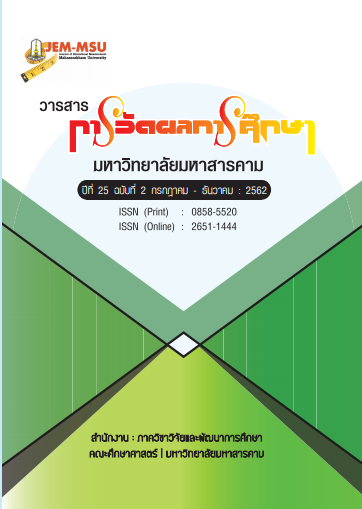The Causal Factors Influencing Digital Literacy of Grade 12 Students in the Northeast Region: Multilevel Structural Equation Model Analysis
Main Article Content
Abstract
This research aimed to develop and examine a multi-level causal relationship model of factors affecting digital literacy of grade 12 students in the Northeast Region. The sample consisted of 2,880 grade 12 students from 120 classes in the Northeast Region, in the second semester of the academic year 2018, derived from multi-stage random sampling. The research instrument was a Likert 5-point rating scale questionnaire inquiring factors influencing digital literacy of grade 12 students, with the discrimination ranging from 0.52 to 0.86 and the reliability from 0.88 to 0.97. The statistics employed in the analysis of data were the arithmetic mean, standard deviation, and analysis of multi-level structural equation model (MSEM). The findings revealed the following:
The multi-level structural equation model of factors affecting digital literacy of grade 12 students in the Northeast Region was in congruence with the empirical data. Every statistical value obtained from checking the validity of the model met the criteria ( = 241.38, df = 121,
/ df = 1.99, CFI = 0.95, TLI = 0.98, RMSEA = 0.01, SRMR = 0.01/0.10), and the component weight values of all observed variables were statistically significant at the level of .01, and the total influence of factors affecting digital literacy at the student level indicated that the parent support (SUPP) had the highest influence size (0.91), followed by motivation (MOTI) (0.39) and self-learning (SELF) (0.21), respectively; and all independent variables at the student level together explained the variance of digital literacy by 85 percent. While at the class level, the influence size of the independent variables was statistically significant at the level of .01 only from the independent learning resources (RESO) variables to the variables according to teachers' teaching behavior (BEHT).
Article Details
The content and information contained in the published article in the Journal of Educational Measurement Mahasarakham University represent the opinions and responsibilities of the authors directly. The editorial board of the journal is not necessarily in agreement with or responsible for any of the content.
The articles, data, content, images, etc. that have been published in the Journal of Educational Measurement Mahasarakham University are copyrighted by the journal. If any individual or organization wishes to reproduce or perform any actions involving the entirety or any part of the content, they must obtain written permission from the Journal of Educational Measurement Mahasarakham University.
References
กระทรวงศึกษาธิการ. (2551). หลักสูตรแกนกลางการศึกษาขั้นพื้นฐานพุทธศักราช 2551. กรุงเทพฯ : กระทรวงศึกษาธิการ.
ชาญสิทธ์ รัตนาวงศ์ไชยา. (2556). ความสัมพันธ์ระหว่างปัจจัยด้านความพร้อมในการเรียนรู้ด้วยการชี้นำตนเองกับความสำเร็จทางวิชาการของนักศึกษานอกระบบโรงเรียนที่ใช้วิธีเรียนแบบทางไกล. วิทยานิพนธ์ ค.ม.(การศึกษานอกระบบโรงเรียน) คณะครุศาสตร์ จุฬาลงกรณ์มหาวิทยาลัย.
ชฎาพร จิตศิลป์. (2559). เทคโนโลยี. [ออนไลน์]. ได้จาก : http://www.gotoknow.org/posts/490852 [สืบค้นเมื่อ 20 มกราคม 2559].
ธิดา แซ่ชั้น. (2559). การรู้ดิจิทัล : นิยาม องค์ประกอบ และสถานการณ์ในปัจจุบัน. วารสารสารสนเทศศาสตร์, 4(34), 116-145.
นงลักษณ์ วิรัชชัย. (2542). การวิเคราะห์อภิมาน. กรุงเทพฯ : คณะครุศาสตร์ จุฬาลงกรณ์มหาวิทยาลัย.
นุชลี อุปภัย. (2556). จิตวิทยาการศึกษา. พิมพ์ครั้งที่ 3. กรุงเทพฯ : สำนักพิมพ์แห่งจุฬาลงกรณ์มหาวิทยาลัย.
พนม คลี่ฉายา. (2557). การรู้เท่าทันสื่อมวลชนกระแสหลักของคนกรุงเทพมหานคร. วารสารนิเทศศาสตร์, 32(2), 1-24.
ลัดดา บุญมาวัน. (2560). ครูกับเทคโนโลยี. [ออนไลน์]. ได้จาก : http://www.l3nr.org/posts/331881 [สืบค้นเมื่อ12 ตุลาคม 2560].
ศุภกิตติ์ ทองสี. (2552). ปัจจัยที่มีผลต่อการใช้เทคโนโลยีสารสนเทศ ของนักเรียนชั้นมัธยมศึกษาปีที่ 3 สํานักงานเขตพื้นที่การศึกษาเพชรบูรณ์ เขต 1: การวิเคราะห์พหุระดับ. ปริญญาครุศาสตรมหาบัณฑิต มหาวิทยาลัยราชภัฏเพชรบูรณ์.
สุขฤทัย มาสาซ้าย. (2556). การศึกษาสภาพปัญหาและความต้องการที่จำเป็นสำหรับสมรรถนะของครูด้านเทคโนโลยีสารสนเทศและการสื่อสารระดับประถมศึกษาในภาคตะวันออกเฉียงเหนือ. วารสารธรรมศาสตร์. ปีที่ 32 ฉบับที่ 1 มกราคม-เมษายน.
สถาบันส่งเสริมการสอนวิทยาศาสตร์และเทคโนโลยี. (2561). คู่มือการใช้หลักสูตร สาระเทคโนโลยี (วิทยาการ คำนวณ) กลุ่มสาระการเรียนรู้วิทยาศาสตร์. [ออนไลน์]. ได้จาก : http://www.scimath.org/e- books/8376/8376.pdf. [สืบค้นเมื่อ 4 กรกฎาคม 2561].
สำนักงานคณะกรรมการพัฒนาการเศรษฐกิจและสังคมแห่งชาติ, สำนักนายกรัฐมนตรี. (2558). (ร่าง) แผนพัฒนาเศรษฐกิจและสังคมแห่งชาติ ฉบับที่ 12 พ.ศ. 2560-2564.[ออนไลน์]. ได้จาก : http://www.nesdb.go.th.[สืบค้นเมื่อ 4 กรกฎาคม 2561].
สำราญ มีแจ้ง. (2557). สถิติขั้นสูงสำหรับการวิจัย: ทฤษฎีและปฏิบัติ. กรุงเทพฯ : โรงพิมพ์แห่งจุฬาลงกรณ์มหาวิทยาลัย.
สุนทรพจน์ ดำรงค์พานิช. (2555).โปรแกรม Mplus กับการวิเคราะห์ข้อมูลทางพฤติกรรมศาสตร์และ สังคมศาสตร์. มหาสารคาม : สำนักพิมพ์มหาวิทยาลัยมหาสารคาม.
อรัญ ซุยกระเดื่อง. (2561). สถิติขั้นสูงสำหรับการวิจัย. มหาสารคาม :โรงพิมพ์มหาวิทยาลัยราชภัฏมหาสารคาม.
อรัญ ซุยกระเดื่อง. (2561). การวิเคราะห์องค์ประกอบการรู้ดิจิทัลของนักเรียนชั้นมัธยมศึกษาปีที่ 6 ในกลุ่มจังหวัดร้อยแก่นสารสินธุ์. วารสารครุศาสตร์ ปีที่ 15 ฉบับที่ 2(29) กรกฎาคม-ธันวาคม.
Hatlevik, O, E., Greta Bjork Guomundsdottir, and Massimo Loi. (2015). Examining Factors Predicting Students’ Digital competence. Information Technology Education, 14 (123 - 137).
Hobbs, R. (2010). Digital and Media Literacy: A Plan of action (knight commission on the information needs of communities in a democracy). Washington, D.C. The Aspen Institute & knight foundation.
Ministry of Education, Office of the Basic Education Commission. (2010). Digital literacy world - class standard school. (In Thai). Bangkok: Agricultural Cooperatives Community of Thailand.
Media Awareness Network. (2010). Digital literacy in Canada: From inclusion to transformation. Retrieved August 20, 2017 from http://www.ic.gc.ca/eic/site/028.nsf/eng/00454.html.
Techataweewan, W., and Ujsara Prasertsin. (2017). Development of digital literacy indicator for Thai undergratduate student using mixed method research. Kasetsart Journal of Social Sciences. Available online 21 July 2017 from https://doi.org/10.1016/j.kjss. 2017.07.001.


